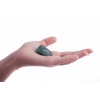|
 Aventurine's name is Italian, coming from the expression «per
ventura» or «by chance». It refers to the discovery of Aventurine by Venetian
glass workers sometime in the 16th or 17th century. Aventurine is a form of
quartz, and is very similar to goldstone and sunstone. Another name for aventurine
is Indian jade. Aventurine's name is Italian, coming from the expression «per
ventura» or «by chance». It refers to the discovery of Aventurine by Venetian
glass workers sometime in the 16th or 17th century. Aventurine is a form of
quartz, and is very similar to goldstone and sunstone. Another name for aventurine
is Indian jade.
Aventurine is most often green, but can also be orange, brown,
blue, gray, peach, greenish-blue, bluish-white, bluish-green, or yellow. The
green hues in aventurine are due to the inclusion of the mineral green
fuschite. Orange, red, and brown hues are due to the inclusion of goethite or
hematite. It is known for its translucency (or often, opacity) and «aventurescence»,
a word describing the mineral inclusions which make the rock shimmer or
glisten.
Others dispute that the secret of making such glass was known
to ancient Egyptians, but was subsequently lost until 17th century. According
to third version, the marvelous gold speckled stone was considered a talisman
during the Gold Rush in America. And since the rush for gold was instigated
mostly by the adventurers, the stone got the name aventurine. The legend has it
that the gold-diggers, who wore aventurine jewelry, always found a rich
deposit. And they say that the gemstone pointed to the deposit where gold was
abundant.
However, the main deposits of aventurine are found in
Austria (in Salzburg area), Russia (Urals mountains), Brazil, Spain (Cap-de
Gata) and India (best known for its deposits of green aventurine, but blue
aventurine is found in Jaipur province). Nevertheless, aventurines are found in
Colorado, they even nicknamed «Colorado gold stones». But it's hard to resist
the romance, and the legends associated with the origin of aventurine's name proliferate,
with no regard for historical authenticity.
They say that aventurine is formed of golden sand, compacted
under high pressure which is nearly as high as that transforming unassuming
graphite into a sparkling diamond. However, this is merely a romantic tale.
Aventurine is a variety of quartz, with inclusions of mica or hematite fine
particles (or, in rare cases, copper particles) or scales of iron-oxide, which
confer brilliancy on the stone. There are no traces of gold, despite the
mysterious «golden» sparkles.
Considered by gems healers to be one of the Mothers' of all
healing stones, aventurine has been bestowed with many healing properties. The
main healing benefit that aventurine is linked with is mentally based, helping
to achieve clarity of mind and thoughts. Aventurine is said to calm a troubled
mind, thereby bringing inner peace. It is also supposed to increase confidence
and gratitude, and promote emotional tranquility and positive attitudes. In
addition, aventurine is considered to be a love talisman, a mystical amulet. A
person who wears aventurine jewelry becomes capable of unexpected actions and
decisions.
But the legends say that despite this beneficial effect, you
shouldn't wear aventurine jewelry all the time. As it turns out, aventurine has
the property to change its spiritual energy depending on the moon phases (it
was believed that this stone is directly linked to the lunar magic). Therefore,
aventurine jewelry can be worn for only one lunar phase, and then it needs «a
break».
In addition, aventurine jewelry is not particularly
recommended for adults, but rather for children under 16. In the old days, they believed
that the properties of the gemstone suggests that it may be worn only by the people
who do not hold high positions, have families or are bound by other
responsibilities or obligations (therefore the age limit).
For Earth and Water signs (Cancer, Scorpio, Pisces,
Capricorn, Taurus, and Virgo) aventurine readily shows its best qualities, especially
if worn when the moon is in decrement. But the Air signs (Libra, Aquarius,
Gemini) better use aventurine jewelry sparely, only on important occasions, for
example, for the first date.
In ancient times, aventurine was believed to relieve allergic
reactions or general apathy. It was also thought to restore the health and
beauty of your hair, therefore aventurine bracelets and necklaces were recommended
in case of hair loss. In cosmetology aventurine was used for removal of warts
and pimples.
Today, it would be difficult to remove warts or grow hair
with aventurine as natural gemstones are not easy to obtain. It's true that shop
counters are literally teeming with aventurine jewelry pieces. However, for the
most part it is not aventurine, but that same glass, whose formula was recovered
by the Venetian glass blowers (copper, iron, chromium and cobalt oxides are
added to the glass melt). And the name «aventurine» on the label is not a
guarantee that it is a gemstone you're buying, as it glass imitation bears the same
name.
The first sign of a fake is too many too bright golden
speckles (in natural gemstones they are less striking). In addition, in natural
gemstone speckles are evenly distributed, while in glass imitations there are both
dense clusters, and completely «blank» areas.
|